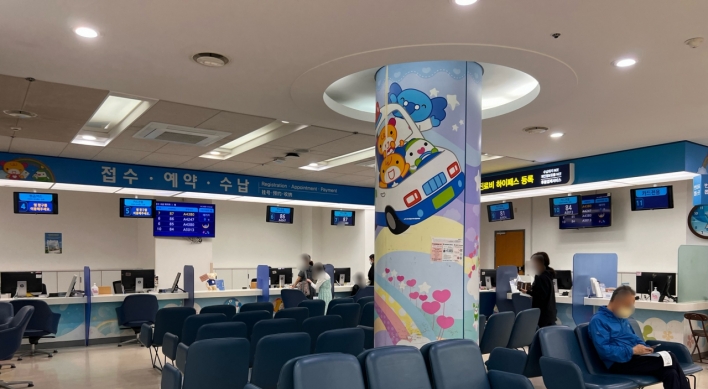Seoul to unveil new satellite for Naro space rocket
By Korea HeraldPublished : Aug. 23, 2012 - 11:39
South Korea will this week unveil a new satellite that it will launch aboard its space rocket later this year, the government said Thursday.
The Science and Technology Satellite-2C (STSAT-2C) will be revealed to the public Friday in a pre-shipment ceremony to be held at the Korea Advanced Institute of Science and Technology (KAIST) in Daejeon, 160 kilometers south of Seoul, according to the Ministry of Education, Science and Technology.
The satellite, indigenously developed by KAIST, is the third of its kind as its two predecessors -- STSAT-2A and STSAT-2B – were lost in failed attempts to launch the country‘s first space vehicles in August 2009 and June 2010.
A new and improved Korea Space Launch Vehicle-1, also known as Naro-1, is scheduled to be launched in October, with the specific launch date to be set later. The country’s first space rocket was developed jointly with Russia.
“It will be the first and last chance (for the public) to see the satellite in real life before the launch as it will be shipped to the Naro Space Center in late August,” the ministry said in a press release.
The 100-kilogram satellite is a test satellite with a short lifespan of less than 1 year that will largely verify the country‘s ability to put a satellite into orbit, as well as its ability to collect science data such as radiation levels in space.
If October’s launch is successful, the satellite will be put into an ellipsoidal orbit of 300 kilometers by 1,500 kilometers, orbiting the Earth in every 103 minutes, according to the ministry. (Yonhap News)
<관련 한글 기사>
돌아온 나로호 ‘직접’ 만나볼 마지막 기회
나로호 발사체에 실려 우주로 날아가게 될 나로과학위성이 24일 처음이자 마지막으로 전시된다고 교육과학기술부가 23일 밝혔다.
전시는 24일 오전 10시부터 오후 5시까지 대전 유성구 KAIST 인공위성연구센터에서 이뤄진다.
KAIST 관계자는 “우리 땅에서 발사하고 국내에서 독자적으로 개발한 나로과학위성의 모습을 공개해 우리나라의 위성개발 역사와 기술에 대한 일반인의 관심을 높이겠다는 뜻”이라고 설명했다.
나로과학위성은 무게 100㎏급, 가로 1m, 세로 1m, 높이 1.5m의 소형위성이다. 궤도 진입에 성공하면 1년간 300∼1천500㎞ 상공의 타원궤도로 지구 주위를 매일 약 14바퀴 돌며 우주환경을 관측하게 된다.
발사에 실패한 1, 2차 나로호 발사체에 실렸던 과학기술위성 2호의 기술을 활용해 순수 국내기술로 개발됐다. 지난해 2월부터 이뤄진 개발에는 KAIST 인공위성연구센터를 비롯한 한국항공우주연구원, i3시스템, 한국항공대학교 등이 참여했고 예산은 약 20억원이었다.
이 위성에는 레이저 반사경, 우주이온층 측정센서(랑뮈어 탐침), 우주방사선량 측정 및 반도체오류 측정센서, 자세제어용 반작용 휠, 펨토초 레이저 발진기, 적외선 소자 영상센서 등이 실려 있다.
특히 펨토초 레이저발진기의 기술이 성공적으로 검증되면 우리나라는 세계 최초로 광섬유를 이용한 펨토초(10의 15거듭제곱 분의 1초) 단위의 정밀거리 측정에 관한 기반기술을 확보할 수 있을 것이라고 교육과학기술부 관계자는 기대했다.
The Science and Technology Satellite-2C (STSAT-2C) will be revealed to the public Friday in a pre-shipment ceremony to be held at the Korea Advanced Institute of Science and Technology (KAIST) in Daejeon, 160 kilometers south of Seoul, according to the Ministry of Education, Science and Technology.
The satellite, indigenously developed by KAIST, is the third of its kind as its two predecessors -- STSAT-2A and STSAT-2B – were lost in failed attempts to launch the country‘s first space vehicles in August 2009 and June 2010.
A new and improved Korea Space Launch Vehicle-1, also known as Naro-1, is scheduled to be launched in October, with the specific launch date to be set later. The country’s first space rocket was developed jointly with Russia.
“It will be the first and last chance (for the public) to see the satellite in real life before the launch as it will be shipped to the Naro Space Center in late August,” the ministry said in a press release.
The 100-kilogram satellite is a test satellite with a short lifespan of less than 1 year that will largely verify the country‘s ability to put a satellite into orbit, as well as its ability to collect science data such as radiation levels in space.
If October’s launch is successful, the satellite will be put into an ellipsoidal orbit of 300 kilometers by 1,500 kilometers, orbiting the Earth in every 103 minutes, according to the ministry. (Yonhap News)
<관련 한글 기사>
돌아온 나로호 ‘직접’ 만나볼 마지막 기회
나로호 발사체에 실려 우주로 날아가게 될 나로과학위성이 24일 처음이자 마지막으로 전시된다고 교육과학기술부가 23일 밝혔다.
전시는 24일 오전 10시부터 오후 5시까지 대전 유성구 KAIST 인공위성연구센터에서 이뤄진다.
KAIST 관계자는 “우리 땅에서 발사하고 국내에서 독자적으로 개발한 나로과학위성의 모습을 공개해 우리나라의 위성개발 역사와 기술에 대한 일반인의 관심을 높이겠다는 뜻”이라고 설명했다.
나로과학위성은 무게 100㎏급, 가로 1m, 세로 1m, 높이 1.5m의 소형위성이다. 궤도 진입에 성공하면 1년간 300∼1천500㎞ 상공의 타원궤도로 지구 주위를 매일 약 14바퀴 돌며 우주환경을 관측하게 된다.
발사에 실패한 1, 2차 나로호 발사체에 실렸던 과학기술위성 2호의 기술을 활용해 순수 국내기술로 개발됐다. 지난해 2월부터 이뤄진 개발에는 KAIST 인공위성연구센터를 비롯한 한국항공우주연구원, i3시스템, 한국항공대학교 등이 참여했고 예산은 약 20억원이었다.
이 위성에는 레이저 반사경, 우주이온층 측정센서(랑뮈어 탐침), 우주방사선량 측정 및 반도체오류 측정센서, 자세제어용 반작용 휠, 펨토초 레이저 발진기, 적외선 소자 영상센서 등이 실려 있다.
특히 펨토초 레이저발진기의 기술이 성공적으로 검증되면 우리나라는 세계 최초로 광섬유를 이용한 펨토초(10의 15거듭제곱 분의 1초) 단위의 정밀거리 측정에 관한 기반기술을 확보할 수 있을 것이라고 교육과학기술부 관계자는 기대했다.
-
Articles by Korea Herald





![[Grace Kao] Hybe vs. Ador: Inspiration, imitation and plagiarism](http://res.heraldm.com/phpwas/restmb_idxmake.php?idx=644&simg=/content/image/2024/04/28/20240428050220_0.jpg&u=)
![[Herald Interview] Mom’s Touch seeks to replicate success in Japan](http://res.heraldm.com/phpwas/restmb_idxmake.php?idx=644&simg=/content/image/2024/04/29/20240429050568_0.jpg&u=)


![[News Focus] Lee tells Yoon that he has governed without political dialogue](http://res.heraldm.com/phpwas/restmb_idxmake.php?idx=644&simg=/content/image/2024/04/29/20240429050696_0.jpg&u=20240429210658)









![[Today’s K-pop] Seventeen sets sales record with best-of album](http://res.heraldm.com/phpwas/restmb_idxmake.php?idx=642&simg=/content/image/2024/04/30/20240430050818_0.jpg&u=)